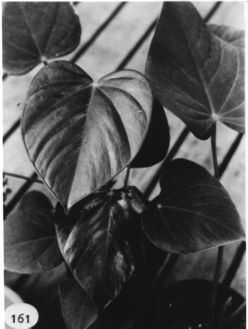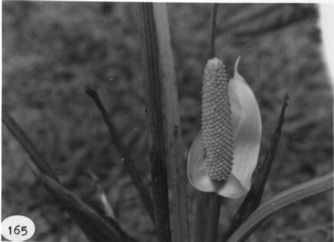




TYPE: Panama. Panama: at summit of Cerro Jefe, ca. 1,000 m, 15.4 mi. above Pan-American Hwy., 9°12'N, 79°22'W, Croat 49090 (MO 2737327, holotype; CAS, CR, F, K, NY, PMA, US, VEN, isotypes; Live at MO).
LEAVES with petioles erect-spreading, 26-58 cm long, 5-7 mm diam., narrowly sulcate, the margins acute, sometimes several ribbed abaxially; geniculum 2-3 cm long; blades moderately thick, ovate, acuminate at apex, deeply lobed at base, (16-)28-49 cm long, (11-) 22-36 cm wide, broadest at point of petiole attachment or just above; anterior lobe (15-)23-34 cm long, the margins rounded, posterior lobes (4.2-)9-13 cm long, from apex of sinus to outermost point; sinus triangular to hippocrepiform, usually acute at apex; upper surface semiglossy with conspicuous round raphide cells; lower surface glossy; midrib acutely raised from base to middle, flat to weakly sunken toward apex above, acutely raised below; basal veins (3-)5-6 pairs, free to the base, sunken above, raised below, posterior rib absent; primary lateral veins 3-6 per side, departing midrib at 40-45° angle, sunken above, raised below, more or less straight to collective vein; interprimary veins weakly sunken above, obscure below; collective vein arising from the first or second basal vein, 3-5 mm from margin, sunken above, raised below.
INFLORESCENCE erect, shorter than leaves; peduncle 10-24 cm long, 4-6 mm diam., one-half to one-third as long as petiole; spathe subcoriaceous, pale green, ovate to broadly lanceolate, 6-10 cm long, 2ų4.5 cm wide, broadest near the base, long-acuminate to cuspidate at apex, rounded, more or less clasping at base; spadix pale green to creamy white, turning violet purple at anthesis, scarcely tapered at apex, (4.5-)6-10 cm long, 8-10 mm diam. near base, 6-8 mm diam. near apex; flowers rhombic, 1.7-1.9 mm long, 1.8-2.1 mm wide, the sides sigmoid, 6-9 flowers visible in the principal spiral, 11-15 flowers visible in the alternate spiral; lateral tepals ca. 1.1 mm wide, the inner margin convex; pistils scarcely emergent; stigmas linear; stamens emerging in a scattered manner, laterals usually emerging throughout before alternates emerge; anthers held at edge of tepals; thecae ovate.
INFRUCTESCENCE erect; spathe usually reflexed; spadix 8-10 cm long, 2-2.3 cm diam.; immature berries rounded at apex, white to pale purple. Figs. 161 and 165.
Anthurium tysonii is endemic to Panama and is known only from the vicinity of Cerro Jefe at 600 to 1,000 m in tropical wet forest. A member of section Calomystrium, it is distinguished by its terrestrial habit, its many-ribbed petioles, its broadly ovate, cordate blades with free basal veins, and by its short pedunculate inflorescence with a white spadix that becomes violet purple in age. The species is confused with no other species in the genus and is the only member of section Calomystrium in North America with free ending basal veins. The usually many-ribbed petiole and the short pedunculate inflorescence make the species unique.
It is named for Dr. Edwin L. Tyson who made some of the earliest collections of the species.
 |
 |
Map of Mesoamerican specimens with coordinates
Panama Colón: 500-550 m, 9.20N 79.45W, 17-18 Apr 1988, Thompson 4872
(MO).
Panama Panamá: 850 m, 9.14N 79.22W, 8 July 1987, Thomas B. Croat 67028
(MO).
Panama Panamá: 770 m, 09.15N 79.29W, 4 July 1994, Thomas B. Croat &
Guanghua Zhu 76609 (CAS, CM, MEXU, MO, NY).